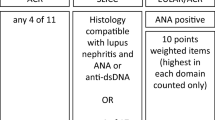Abstract
Rheumatoid arthritis (RA) is an autoimmune disease characterized by symmetric polyarthritis, rheumatoid factor (RF) positivity, and bone erosions. Recently, research has been conducted on anti-citrullinated peptide antibodies (ACPAs) to which there are greater sensitivity and specificity than RF. However, these antibodies have also been described in infectious diseases, particularly tuberculosis (TB), placing the high specificity of the test in doubt. The aim of this research was to study the prevalence of ACPAs in TB, RA, and healthy controls. Patients with bacteriologically confirmed pulmonary tuberculosis, RA (ACR criteria), in addition to healthy controls were included. ACPAs were researched by: anti-cyclic citrullinated peptide (CCP), anti-modified citrullinated vimentin (MCV), and RF by ELISA. The study was conducted in 50 TB patients, 50 with RA, and 20 controls. Anti-CCP antibodies were found in 39 (78 %) of the RA patients (median titer, 128 U), whereas anti-MCV antibodies were found in 25 (50 %). Of the patients with TB, two (4 %) had positivity for anti-CCP and anti-MCV and no patient in the control group tested positive for these antibodies. Sensitivity of anti-CCP for RA was 78 % (confidence interval (CI), 63 to 88 %) and specificity was 97 % (CI, 89 to 99 %) while the sensitivity of anti-MCV was 50 % (CI, 35–64 %) and specificity was 97 % (CI, 89 to 99 %). RF was positive in 40 samples (80 %) of RA, in 30 (60 %) of TB, and in 1 (5 %) of the controls. Our findings showed high sensitivity of anti-CCP and high specificity of both anti-CCP and anti-MCV antibodies for RA, even in a population with high incidence of tuberculosis. The higher frequency of positivity of ACPA in TB observed in previous studies may be attributed to methodological factors.
Similar content being viewed by others
References
Symmons DP, Barrett EM, Bankhead CR, Scott DG, Silman AJ (1994) The incidence of rheumatoid arthritis in the United Kingdom: results from the Norfolk Arthritis Register. Br J Rheumatol 33(8):735–739
Marques Neto J, Gonçalves E, Langen L, Cunha M, Radominski S, Oliveira S et al (1993) Estudo multicêntrico da prevalência da artrite reumatóide do adulto em amostras da população brasileira. Rev Bras Reumatol 33:169–173
Senna ER, De Barros AL, Silva EO, Costa IF, Pereira LV, Ciconelli RM et al (2004) Prevalence of rheumatic diseases in Brazil: a study using the COPCORD approach. J Rheumatol 31(3):594–597
Aletaha D, Neogi T, Silman AJ, Funovits J, Felson DT, Bingham CO III et al (2010) Rheumatoid arthritis classification criteria: an American College of Rheumatology/European League Against Rheumatism collaborative initiative. Arthritis Rheum 62(9):2569–2581
Arnett FC, Edworthy SM, Bloch DA, McShane DJ, Fries JF, Cooper NS et al (1988) The American Rheumatism Association 1987 revised criteria for the classification of rheumatoid arthritis. Arthritis Rheum 31(3):315–324
Mota LM, Laurindo IM, Santos Neto LL (2010) Early rheumatoid arthritis: concepts. Rev Assoc Med Bras 56(2):227–229, Mar
Goldbach-Mansky R, Lee J, McCoy A, Hoxworth J, Yarboro C, Smolen JS et al (2000) Rheumatoid arthritis associated autoantibodies in patients with synovitis of recent onset. Arthritis Res 2(3):236–243
Schellekens GA, Visser H, de Jong BA, van den Hoogen FH, Hazes JM, Breedveld FC et al (2000) The diagnostic properties of rheumatoid arthritis antibodies recognizing a cyclic citrullinated peptide. Arthritis Rheum 43(1):155–163
Whiting PF, Smidt N, Sterne JA, Harbord R, Burton A, Burke M et al (2010) Systematic review: accuracy of anti-citrullinated peptide antibodies for diagnosing rheumatoid arthritis. Ann Intern Med 152(7):456–464, Apr 6
Elkayam O, Segal R, Lidgi M, Caspi D (2006) Positive anti-cyclic citrullinated proteins and rheumatoid factor during active lung tuberculosis. Ann Rheum Dis 65(8):1110–1112
Elkayam O, Segal R, Bendayan D, Van UR, Onnekink C, Pruijn GJ (2010) The anti-cyclic citrullinated peptide response in tuberculosis patients is not citrulline-dependent and sensitive to treatment. Arthritis Res Ther 12(1):R12
Kakumanu P, Yamagata H, Sobel ES, Reeves WH, Chan EK, Satoh M (2008) Patients with pulmonary tuberculosis are frequently positive for anti-cyclic citrullinated peptide antibodies, but their sera also react with unmodified arginine-containing peptide. Arthritis Rheum 58(6):1576–1581
Mori S, Naito H, Ohtani S, Yamanaka T, Sugimoto M (2009) Diagnostic utility of anti-cyclic citrullinated peptide antibodies for rheumatoid arthritis in patients with active lung tuberculosis. Clin Rheumatol 28(3):277–283
Silva A, Matos A, Lima A, Lima E, Gaspar A, Braga J et al (2006) Valor diagnóstico do anticorpo antipeptídeo citrulinado cíclico na artrite reumatóide. Rev Bras Reumatol 46:174–180
Nienhuis RL, Mandema E (1964) A new serum factor in patients with rheumatoid arthritis; the antiperinuclear factor. Ann Rheum Dis 23:302–305
Santiago M, Baron M, Miyachi K, Fritzler MJ, Bu-Hakima M, Leclercq S et al (2008) A comparison of the frequency of antibodies to cyclic citrullinated peptides using a third generation anti-CCP assay (CCP3) in systemic sclerosis, primary biliary cirrhosis and rheumatoid arthritis. Clin Rheumatol 27(1):77–83
Lima I, Santiago M (2010) Antibodies against cyclic citrullinated peptides in infectious diseases—a systematic review. Clin Rheumatol 29(12):1345–1351
Acknowledgments
M.S. receives a scholarship from the Conselho Nacional de Desenvolvimento Científico e Tecnológico. We are indebted to the pneumologists of Hospital Otávio Mangabeira, where the TB patients came from.
Disclosures
None.
Author information
Authors and Affiliations
Corresponding author
Rights and permissions
About this article
Cite this article
Lima, I., Oliveira, R.C., Atta, A. et al. Antibodies to citrullinated peptides in tuberculosis. Clin Rheumatol 32, 685–687 (2013). https://doi.org/10.1007/s10067-013-2173-y
Received:
Revised:
Accepted:
Published:
Issue Date:
DOI: https://doi.org/10.1007/s10067-013-2173-y




